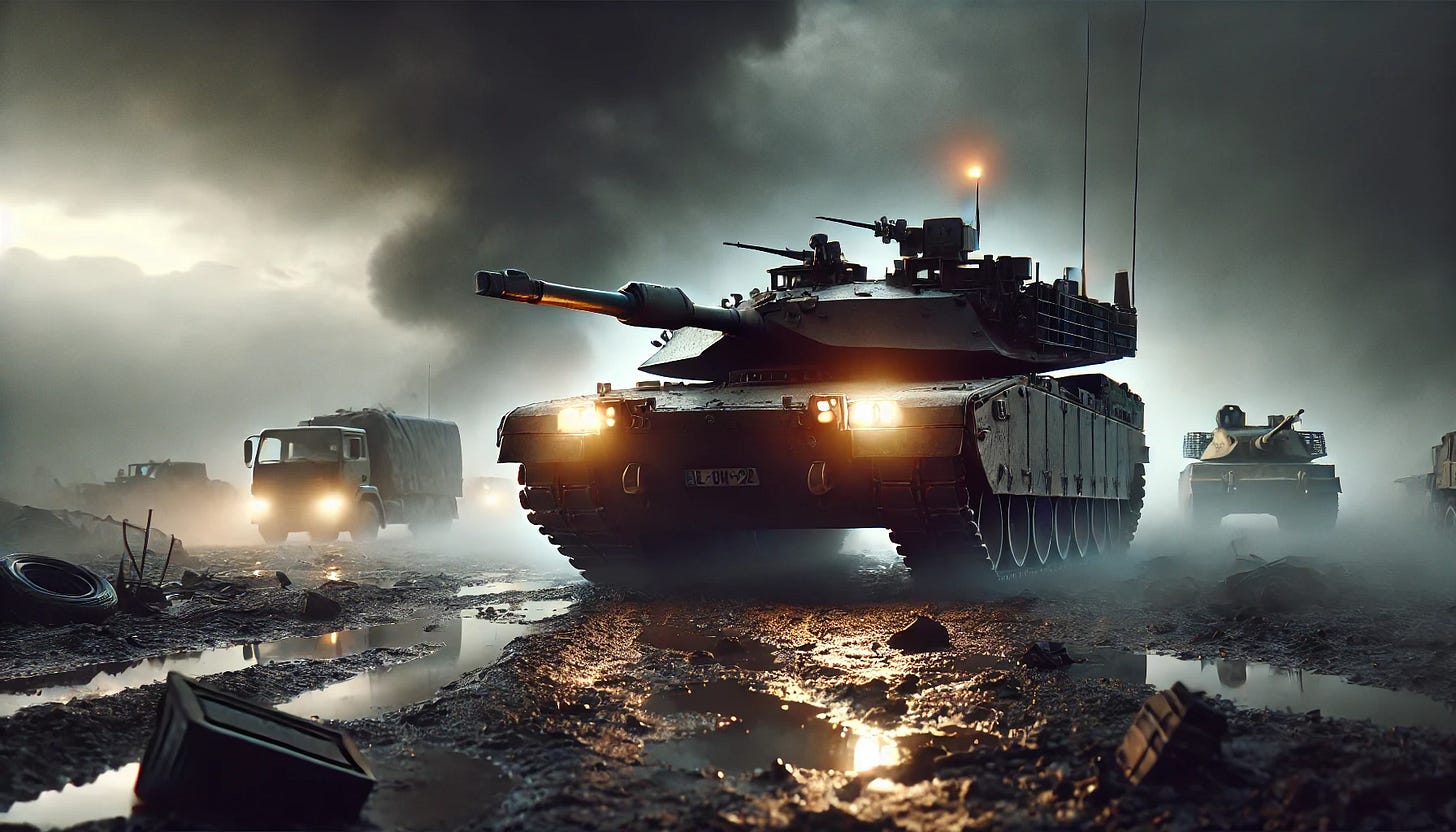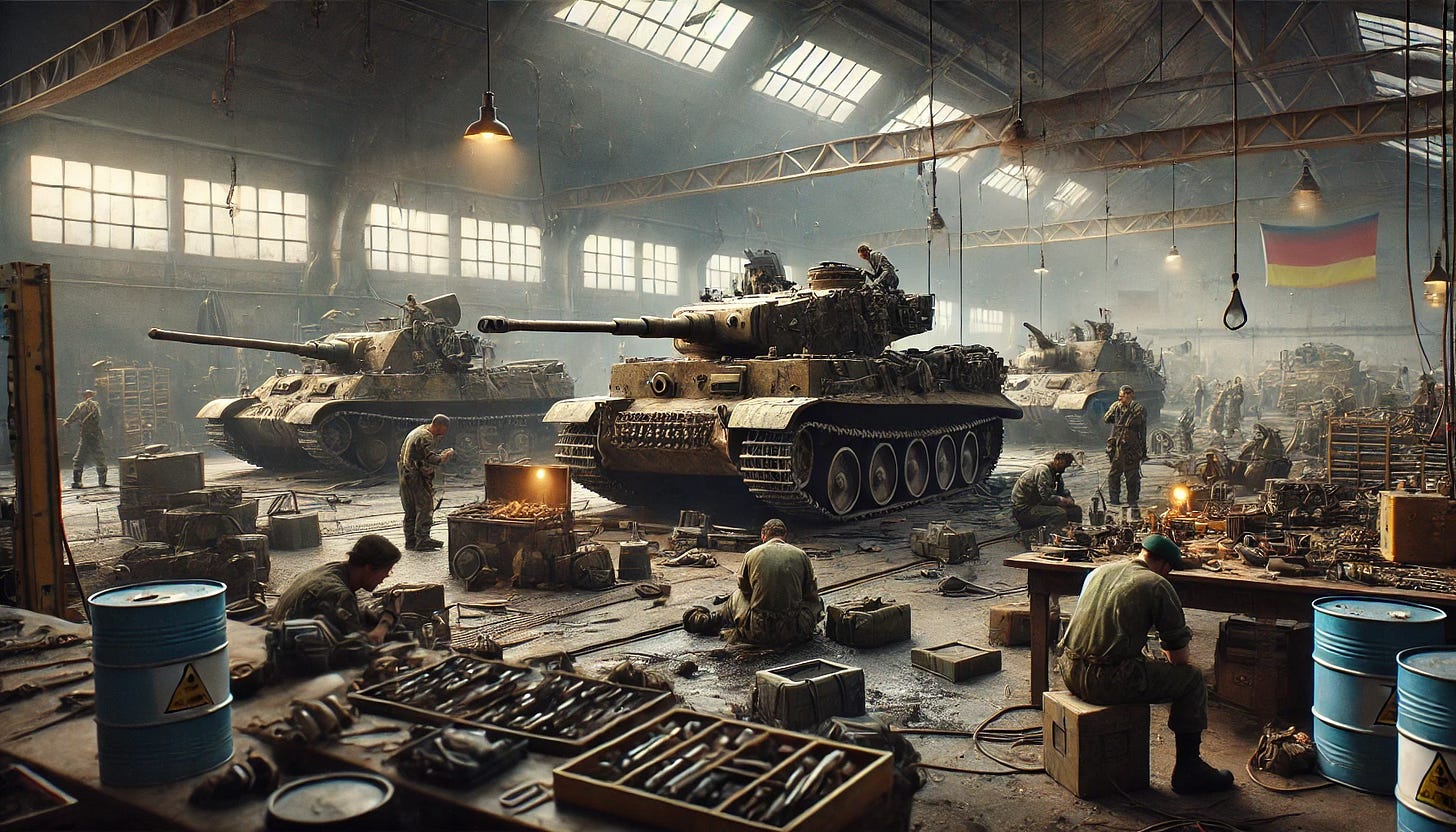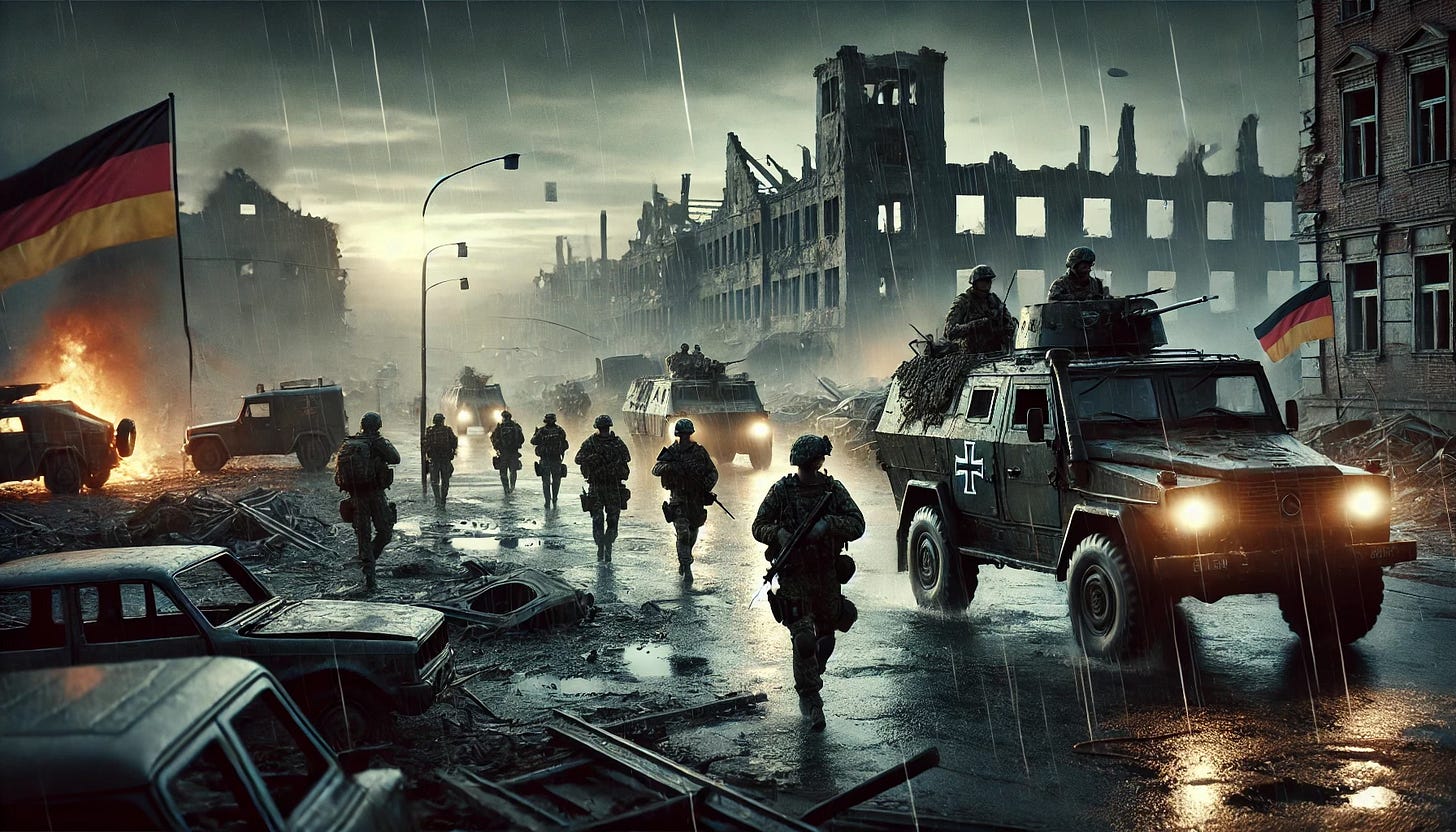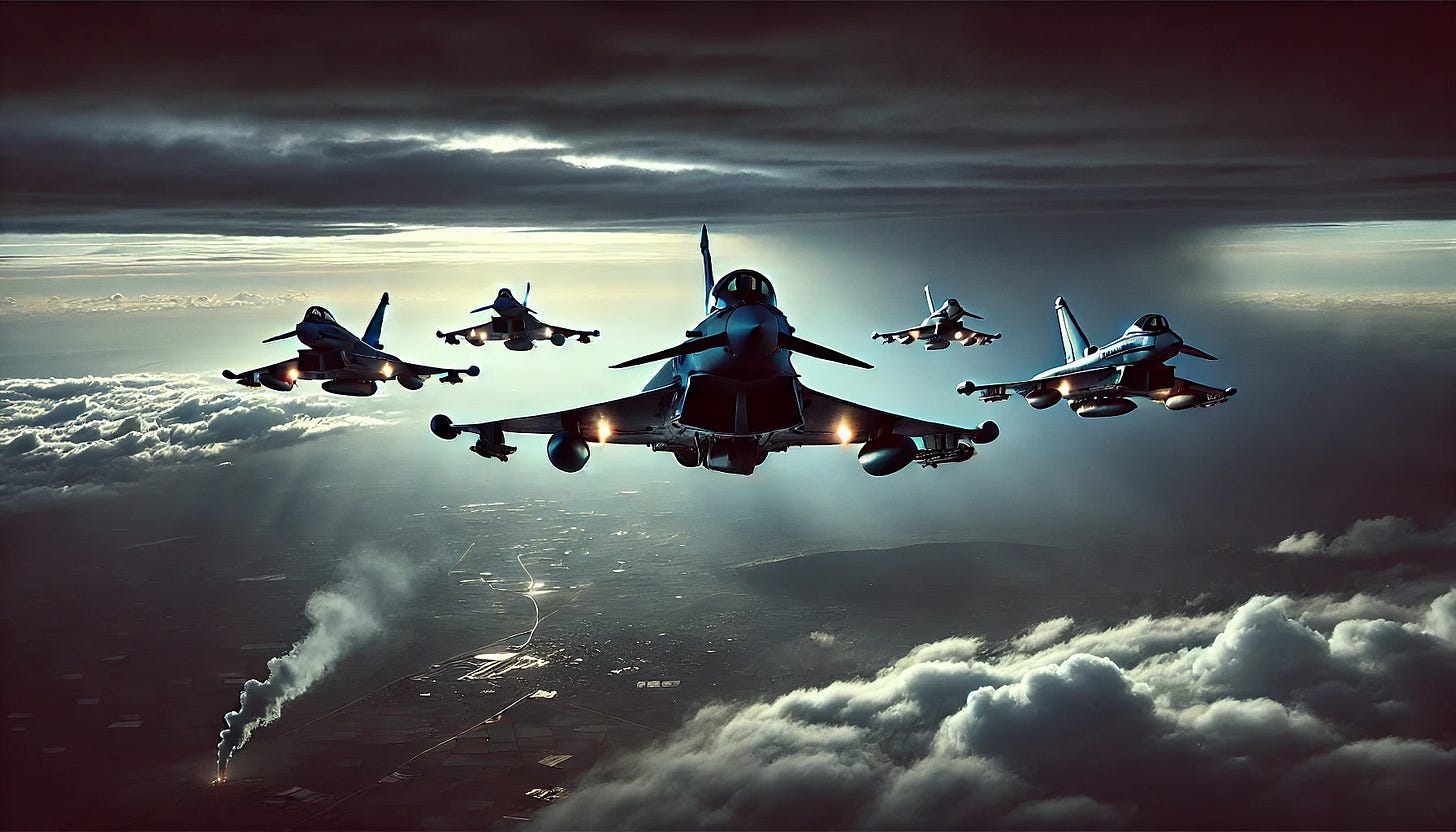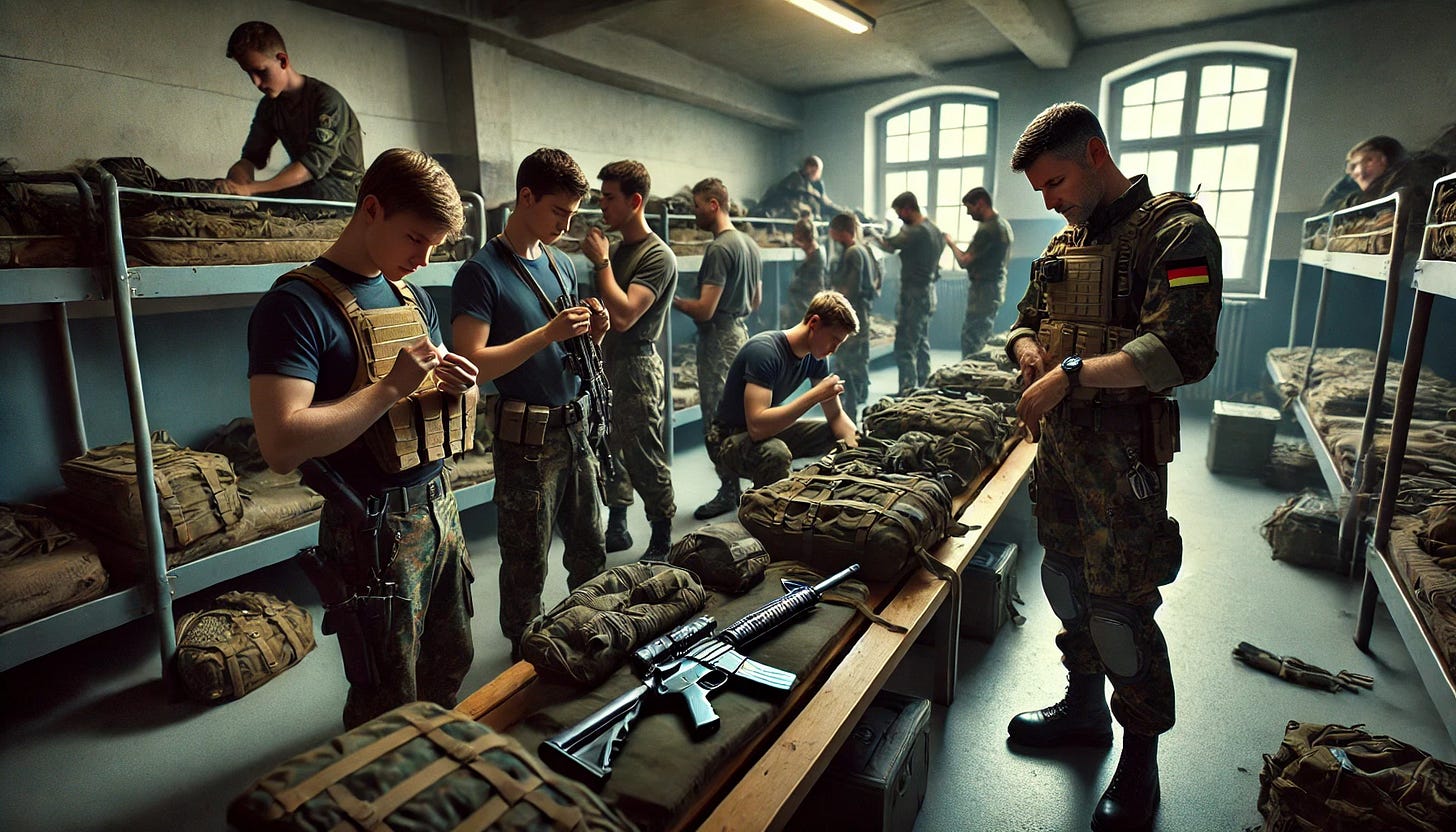How About an Answering Machine With the Message: “We Surrender”?
The German Defense — the Bundeswehr — Is in Such Tatters That It Needs an Obscene Amount of Euros to Get Back in Shape. The Money May Now Be on the Table — but Is There Enough Time?
“Endless columns of grey-clad men, with fixed bayonets and iron discipline, marching six abreast, silent and relentless, like a machine.”
In August 1914, at the outbreak of the First World War, the German army looked invincible to this Belgian eyewitness in the city of Liège.
“From the windows of Belgian towns, the people watched the Germans march through — mile after mile of infantry, wagons, and artillery... They came like a river of men, organized, quiet, and utterly alien,” the historian Barbara Tuchman wrote in her book The Guns of August.
A little more than 110 years ago, the imperial German army was one of the strongest in the world.
And today?
“How are the mighty fallen, and the weapons of war perished!” as King David laments in the Bible (Second Samuel 1:27) — yes, the slingshot guy who dropped the giant.
The modern German defense, the Bundeswehr, is not a river of men anymore, but rather a slight trickle, soon to dry up in the heat of early summer.
Seriously, dude
Before we get to the sorry state of the Bundeswehr, let’s for a moment look at the imperial German army of 1914. The standing army in 1914 was 800,646 strong, with an officer corps of 30,739 and the rest privates and non-commissioned officers. That was about 1.2 percent of the entire population. In wartime, that figure swelled to 13.25 million men, counting conscripts, reservists, and every Tom, Dick, and Harry I might have forgotten.
This massive army was furnished with the most modern weapons from one of the most advanced industrial machines of that time. Before the outbreak of the First World War, even the battleships of the British Royal Navy were being built with steel from mills in the Ruhr district, right here in Nordrhein-Westfalen.
I can almost hear you object:
“Seriously, dude, you can’t compare an army from more than 110 years ago to a modern mobile army with tanks and armored personnel carriers — not to mention drones and HIMARS rockets that can hit targets hundreds of kilometers away. Come on, you can do better than that. And if not, I’m the f… outta here.”
And for sure, you do have a point. But sadly, so have I.
It is true that the role of the German army has shifted dramatically. It is no longer commanded by Prussian Junkers with handlebar moustaches and pointy helmets. It no longer has a Schlieffen Plan to defeat France before turning on Russia.
However, it also highlights Germany’s current limitations — in mass, readiness, and strategic seriousness. Germany’s Imperial Army in 1914 mobilized millions within weeks, drawing on deep reserves and a militarized society. The Bundeswehr today struggles to recruit just 200,000 volunteers, lacks basic ammunition, and debates whether to even mention the word “Kriegstüchtigkeit” (war capability). And seriously, I personally doubt that Generation Z will be willing to fight for values like democracy in a struggle against a totalitarian regime like Putin’s Russia — just look at protests like Queers for Palestine, cheering for a repressive Hamas that wouldn’t tolerate them for long in Gaza.
Germany was once a country that could launch a multi-front war and sustain it for four years. Today, it cannot independently defend its own airspace or conduct intensive operations for more than a few days.
Something to believe in
We’ll get back to that, but just to push my point a little further, let’s hop, skip, and jump just a few decades back in time to the Cold War — a time when the USA and Western Europe still had an alliance they believed in… except, of course, for the left of the political spectrum, who were cheering for the other side in the name of such things like solidarity with oppressed masses (not Ukrainians, Latvians or Georgians of course) and Mao’s Great Leap Forward (which cost in the vicinity of 30 million lives).
The West German Bundeswehr was created in 1955 with a mandate to defend Western Europe against the communist Orcs of the East after World War II. During the Cold War, West Germany’s military grew into a large conscript force. By the 1980s, the Bundeswehr boasted around 495,000 active personnel, including conscripts serving around 12–15 months, plus reservists.
By the late Cold War, the Bundeswehr was regarded as a “schlagkräftige Verteidigungs- und Abschreckungsarmee” (potent defense and deterrence army) within NATO. Annual defense spending often exceeded three percent of GDP – and even five percent in early decades in the buildup of the German defense.
Today when the threat from the East seem to loom large, the German defense like so many other European looks like a threadbare rag doll that have taken a joyride in the drier far too many times. Just take Schleswig-Holstein. A few years back I looked into the consequences of the downsizing of the Bundeswehr in that state. In the course of 20 years some 27,267 jobs disappeared.
When I then interviewed Dr. Stefan Hansen who leads Institut für Sicherheitspolitik an der Universität Kiel(ISPK) he said:
“The combat forces were generally reduced. The Europeans de-prioritized their defense. In other words, they benefited from the fact that the Americans were footing the bill for their security.”
Today, in 2025, the Bundeswehr is a much smaller all-volunteer force of about 180,000 active soldiers (plus a small volunteer conscript-equivalent cohort). It is less than a third of its size during the Cold War. Conscription was suspended in 2011, reflecting the post-1990 belief that large territorial armies were no longer needed. Instead of thousands of battle tanks, the Bundeswehr has some 250–300 operational main battle tanks.
What are friends for?
After all, a war against the East was a thing of the past. Russia and Germany were friends, right? And just look at all the cheap gas they sold us. What could possibly go wrong?
Critical shortfalls in the Bundeswehr are documented in multiple areas: munition stocks and weapons inventories are so depleted that experts estimate Germany could only fight “a war like Ukraine’s for a few days” with current resources. In 2022, it emerged the Bundeswehr lacked sufficient serviceable combat vehicles and artillery for sustained operations, and as of 2023 it still has “erschreckend geringe Munitionsvorräte” (alarmingly low ammunition reserves).
Reports indicate only a fraction of key equipment is mission-ready at any time. In plain speak that means that aircraft, tanks and helicopters often are below 50 percent availability. Air defense and drone defense capabilities are underdeveloped – the Defense Ministry admits these are major capability gaps, and it remains “unclear” when enough modern systems will reach the troops.
Even basic personal gear and spare parts have been lacking in recent years. This erosion of readiness has occurred even as Germany faces a more demanding security environment. A recent analysis bluntly concluded:
“For a longer fight against a well-armed opponent, the basic prerequisites are missing.”
Germany has too little ammunition, not enough effective drones, and too weak an air defense, with the Navy and Air Force in similar straits. In essence, today’s Bundeswehr is far from the high-readiness force of the 1980s, even though it's much smaller now.
Who is to blame?
I won’t go into who did what — or especially who didn’t do what. It’s too easy to point greasy fingers at some politicians or generals, all too conveniently forgetting that we, the voters, also ignored the warnings. It would be like blaming the financial crisis exclusively on the banks without a word about the politicians — or the consumers who also rode the wave of ignorant bliss. We all have soot-stained fingertips from this mess.
The interesting question is whether we can fix this and present Vladimir Vladimirovich Putin or his successor with a credible defense.
A recent study from the Kiel Institut für Weltwirtschaft (theKiel Institute for the World Economy) gives concrete examples: at today’s rate, reaching the Bundeswehr’s 2004 inventory would take around 15 years for fighter jets, in the neighborhood of 40 years for tanks, and nearly 100 years for artillery systems.
Somehow, I don’t think that the Russian government or any other enemy will give Germany that time to get up to speed. Do you?
Yes, the new government with Friedrich Merz as Kanzler is ready to spend 600 billion euros on infrastructure over the next 12 years. That is a lot of money, some of which supposedly will be used to beef up the Bundeswehr.
On top of that, in March 2025, the German parliament approved a constitutional amendment that exempts defense expenditures exceeding one percent of GDP (Gross Domestic Product, among friends) from the country's "debt brake" fiscal rules. This change allows for significant borrowing to fund defense initiatives without violating fiscal constraints.
That looks reassuring, doesn’t it?
At least on the surface.
But what happens when we look beneath the painted sky of fluffy clouds … and pink unicorns?
Paid in blood
Of course, it’s nice that the new Kanzler wants to invest funds to rebuild the Bundeswehr, but money spent is not the same as money that actually increases the ability to fight an invader — like, for instance, Russia. A potential enemy that has had time to develop new, battle-tested tactics in Ukraine — something Germany, or any other NATO country, hasn’t. There is a vast difference between observing a war, even up close, and actually fighting it.
Like another hero of mine, Ulysses S. Grant, said:
“I don't underrate the value of military knowledge, but if men make war in slavish obedience to rules, they will fail.”
Generals always start out preparing for the last war, and the soldiers — the grunts on the ground — pay for that. In blood.
As in the First World War, where armies began the slugfest with cavalry and brightly colored uniforms — both quite useless and dangerous in trench warfare with barbed wire and Gatling guns.
Admittedly, the new Kanzler doesn’t start from scratch. His predecessor, Mr. Olaf Scholz, proclaimed a Zeitenwende (a historic turning point) in February 2022, intending to overhaul the Bundeswehr to prepare it for further Russian aggression. He pledged an extra 100 billion euros in defense spending. As a consequence, the Bundeswehr has, for instance, ordered 123 Leopard 2A8 Main Battle Tanks and 35 F-35 Lockheed Martin fighter jets.
Sure, that’s expensive hardware, but take a closer look at those numbers. They are puny when you look at the expenditure of military hardware in Ukraine and probably wouldn’t last long in a prolonged fight on a drone-riddled battlefield. Then again, it’s just an uneducated guess. I have only a year and a half’s experience as a drafted amateur soldier some three or four decades ago, so go ahead and laugh your heart out.
That, however, doesn’t change the fact that Europe — and even the U.S. — doesn’t have the production capacity comparable to what there was under the Cold War. Some analysts suggest it may even take decades for Germany and Europe to match Russia's current weapons production volumes.
Rebuild from scratch
Add that to the dismal findings from Kiel. On top of that layered cake, you can add the bureaucratic mechanisms that prevail in all of German society.
Then once more we are back to the fact that we likely won’t have the time to build up that capacity before the next conflict — or whatever might be in store for Germany and the rest of Western Europe.
The second problem is culture: building an army that can and will fight takes can’t be fixed inside the next year or so. Any management guru or CEO in a well-oiled three-piece suit will admit that a change of culture often takes years, even decades.
At least that is what I have heard them say in countless interviews in my years as a business journalist.
In the time of the First World War, the German armies were commanded mostly by Prussian officers steeped in a military tradition that can be traced back to the father of Friedrich der Große in the 17th century. It might seem bizarre to us, but it worked — and it worked very well in its time.
Now, you can argue that this strict, hierarchical, and militaristic culture has no place in modern-day warfare, and you might be right. I don’t dispute that. But it must be replaced with a culture that makes soldiers fight as a cohesive unit.
And it doesn’t help that the younger generations have grown up disconnected from any sense of urgency when it comes to defending their country. In their memory, there has never been a need to think about such matters.
Even proposals to introduce a short period of “Wehrpflicht light” have been met with opposition. And political wishful thinking have so far not changed that.
So why not just set up an answering service with a prerecorded message for any invaders:
“We surrender.”
Last Words and Rites
Now, just a short word about me, your despondent soldier from the trenches in Münster:
I officially moved across the border from Denmark to Germany in April 2014. I like it here, although my address has changed more than a few times since then. Except for a 10-month detour through Italy, I’ve been here ever since, now living in Münster, North Rhine-Westphalia, with my lovely wife and drooling English Mastiff, a dainty little thing weighing in at 74 kilos.
This is where I share my insights on how to navigate life here—basically, it’s a survival guide for foreigners. I’ll share what to do and what to avoid (at all costs). And just to lighten things up, I’ll occasionally share some great tips on places to visit or try out (Geheimtipp). The first tip is about a place where you can get the best beer I’ve tasted so far here. If you care to look, I have unlocked it for you to read. After two or three months depending on my mood I unlock the articles here. If you don’t want to wait, you can chose to be a paying subscriber (pretty please).
An apologetic side note:
Now, you might be wondering why I’m writing this in English and not in Danish or German. The answer is simply to reach a wider (or maybe non-existent) audience and to share how to get by here in Germany. And my not-so-perfect English seems like a fitting choice. I will probably make some grammatical errors, but I hope that ChatGPT 3.5 and Microsoft Word will catch most of them. All images, except photos, have been generated by an AI tool.


